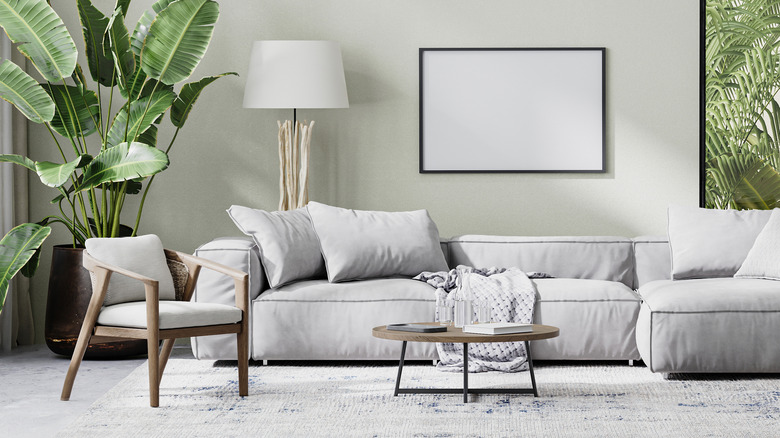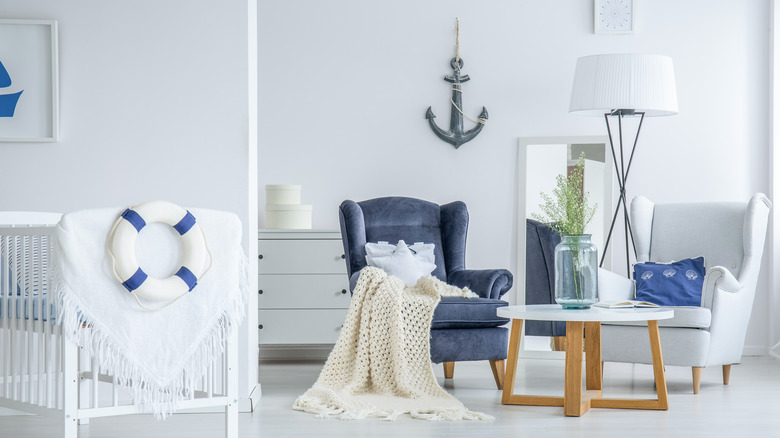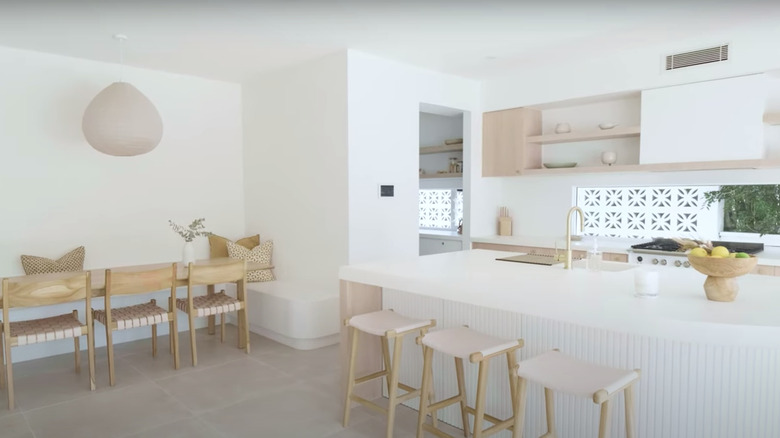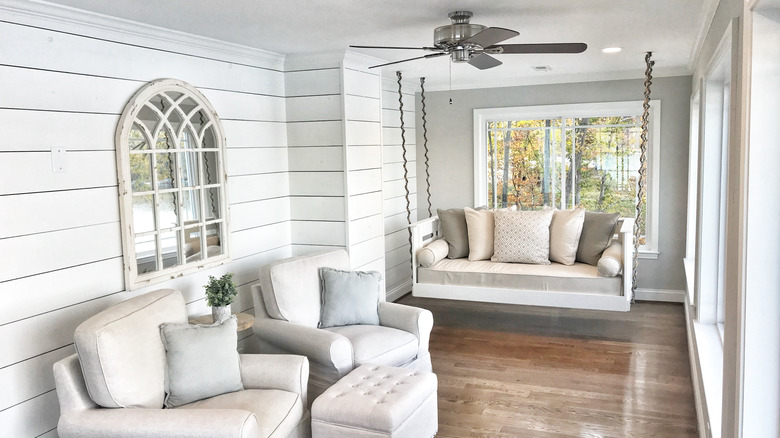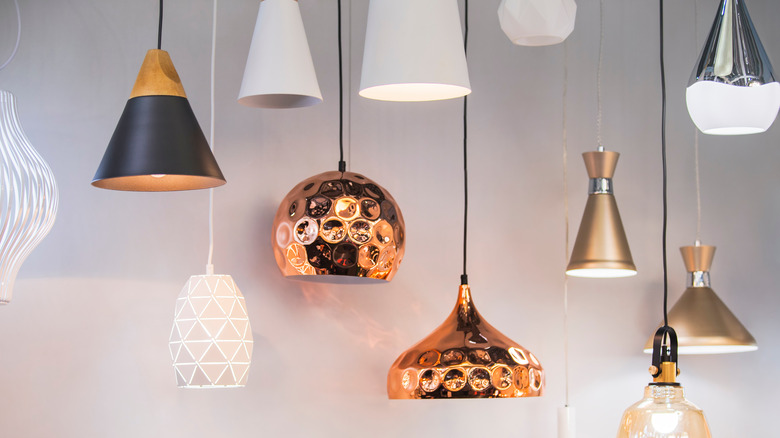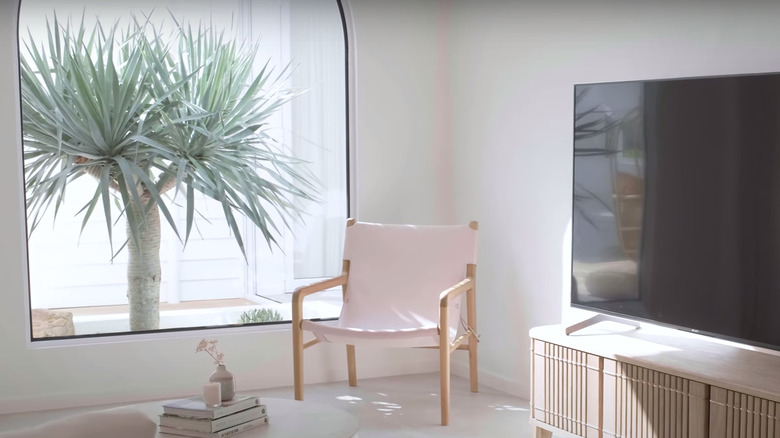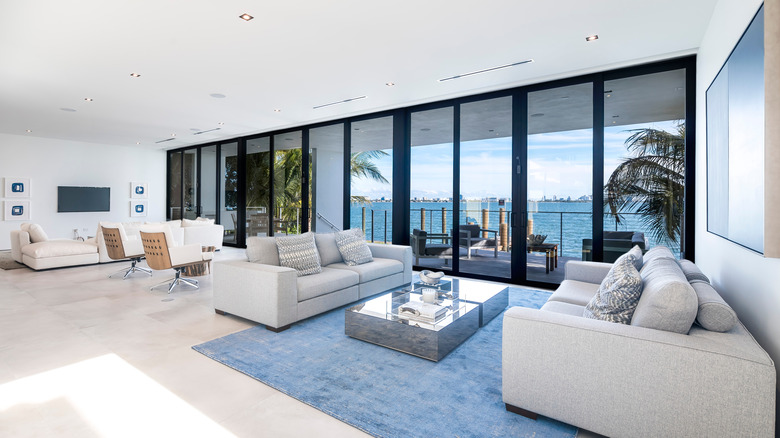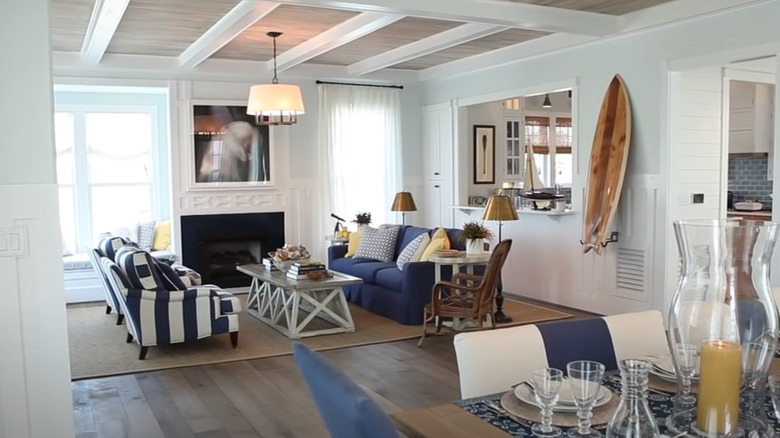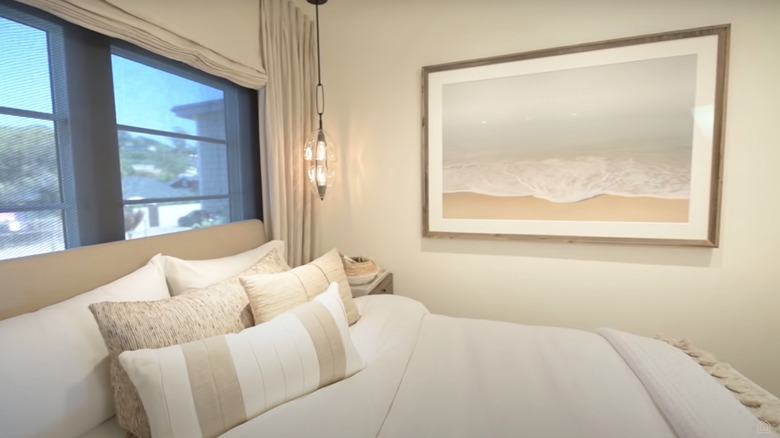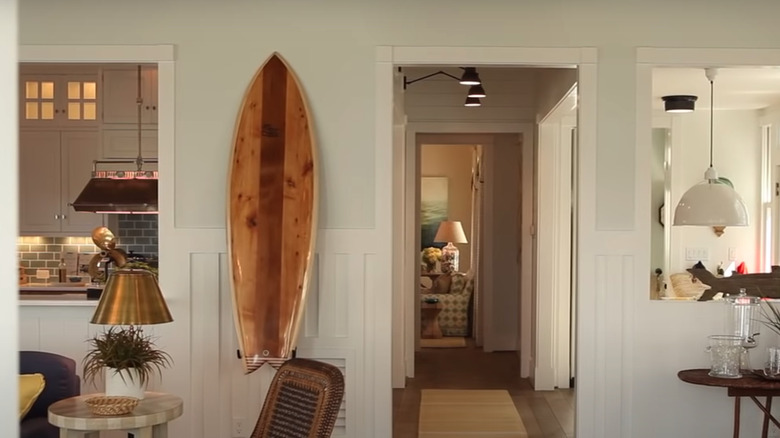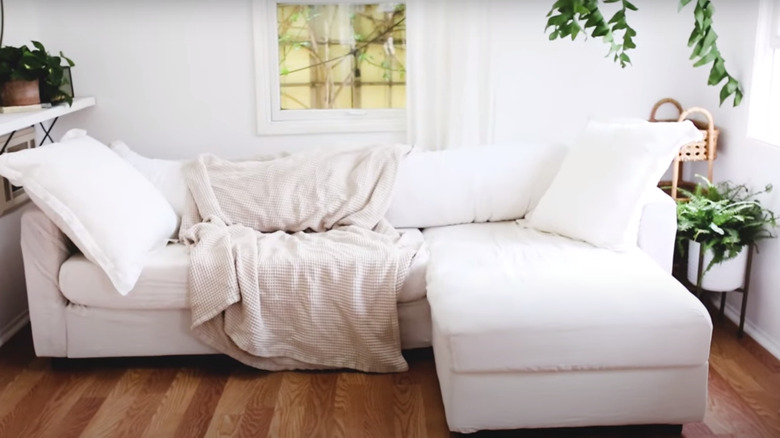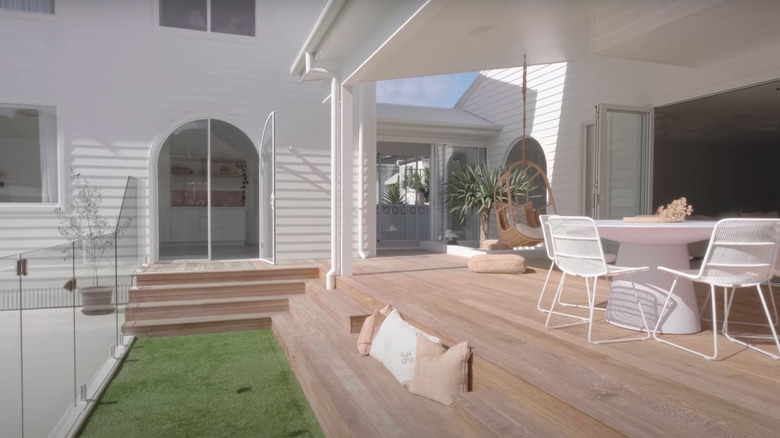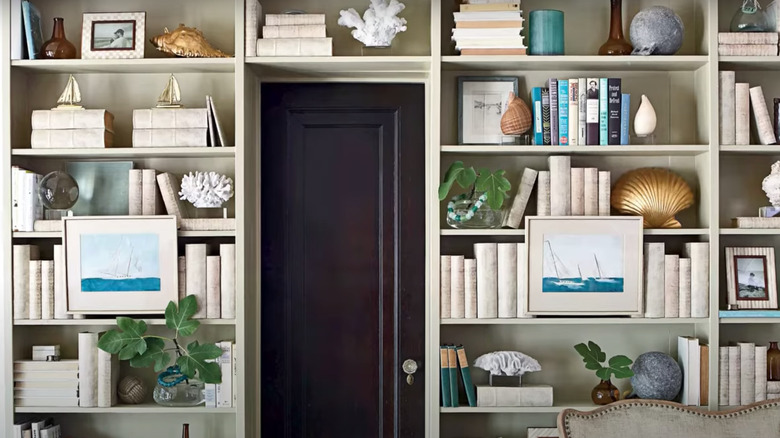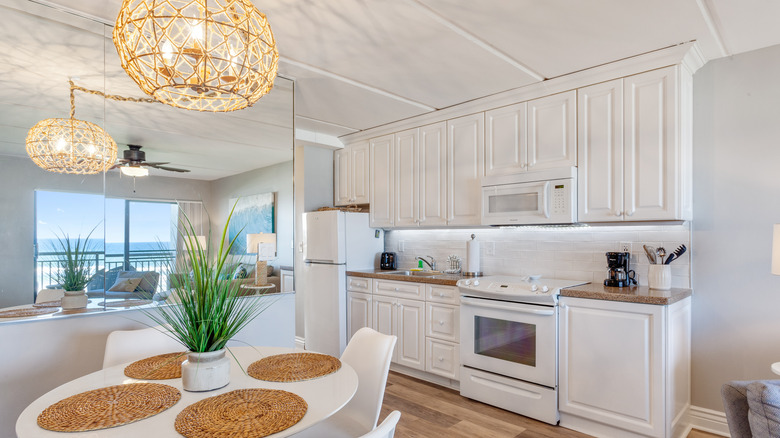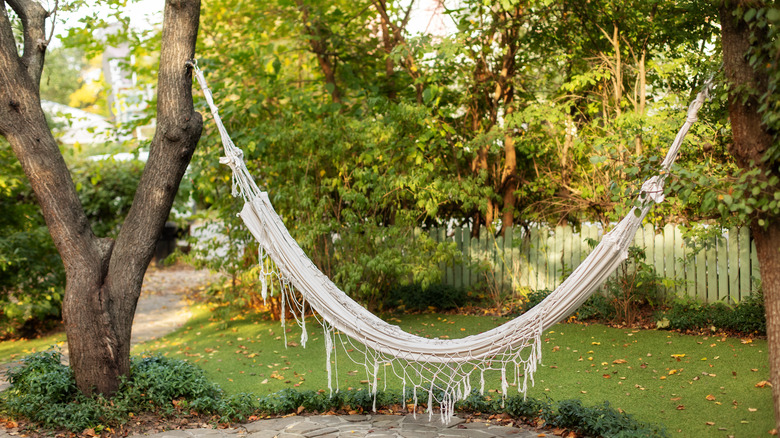How To Decorate Your Home Like A Beach House
Life's always a beach when your home feels like a day out at the seaside. According to The Spruce, people have been decorating their beach and waterfront homes in the coastal style for centuries. While the style began on the Atlantic coast, every region and climate has its own unique take on the style. Even if you don't live next to the ocean, you can still bring cool, coastal design into your home with a few styling tips and tricks.
At its core, the beach house style is all about drawing inspiration from natural elements like sand, surf, and sky, especially for the color palette and the materials you incorporate into your home (via House Beautiful). Natural materials like jute, rattan, and weathered woods give interiors a laid-back and relaxed atmosphere. And prioritizing natural light, crisp whites, and open, airy spaces will help transport you to the coast. Although you can certainly add some nautical-inspired elements like seashells and glass bottles for decoration, moderation is key. Keep reading for more tips on how to bring the breezy spirit of the ocean into your home.
Embrace nautical influences without going overboard
The first rule of coastal style: Don't go overboard with those anchors! According to Homes & Gardens, over-the-top nautical decor looks outdated and kitschy. A wall full of anchors or a sign that says "This way to the beach" are best left avoided. Having too many decor pieces will also make your space feel cluttered, which goes against the minimalism of coastal style. However, you can still summon the sea into your home by incorporating more subtle references like blue and white color palettes or lighting fixtures with coral elements.
Of course, you can decorate with seashells and other ocean-inspired pieces in a way that feels fresh and cool. Place a bowl full of decorative starfish, sand dollars, and seashells on a coffee table, or add a little dose of the coast with a shell-covered mirror or picture frames (via Southern Living). Sea glass bottles are cool and natural without feeling clichéd.
Look for natural materials like weathered wood and rattan
Bringing the outside in with natural materials like wood, rattan, and wicker will help your home feel instantly more relaxing. According to House Beautiful, coastal design is all about the natural environment, so furnishings are usually made of materials like weathered wood, wicker, and rattan. Jute or seagrass are common materials for rugs, and linen and cotton also appear in curtains, bedding, and elsewhere. If you want to nail the coastal aesthetic, stay away from shiny, metallic, or synthetic materials.
When implementing coastal design, it's important to incorporate easygoing furnishings and materials that can resist things like sand and wet swimsuits (via The Spruce). Rattan is particularly popular for coastal-style homes since it is lightweight, environmentally friendly, and not affected by high temperatures or humidity (via The Spruce). Plus, the eye-catching, golden material makes every day feel like a vacation. Whether you add in a rattan armchair, woven baskets, or other accents, your home will instantly look more coastal cool.
Achieve a laid-back coastal atmosphere with shiplap walls
While it's impossible to talk about shiplap these days without mentioning Joanna Gaines and the modern farmhouse aesthetic, these trendy weathered wooden boards are also a hallmark of coastal style. As reported by Real Simple, shiplap refers to horizontal panels that were historically used to waterproof ships against harsh elements. The planks feature distinct grooves, cut on top and bottom, that allow them to fit together securely. Now, shiplap is primarily used for aesthetic purposes since it can effortlessly add coziness and character anywhere, including coastal-themed homes.
If you're feeling inspired to take on a DIY project, why not install your own shiplap walls? To complete the relatively simple (and inexpensive) process, you'll need about three days and some power tools (via Better Homes & Gardens). Start by measuring your wall to determine board length. Walls should be prepped and primed before installation. Then, cut your 4x8 foot planks to a width of 6 inches before painting. Find studs, ensure the level, and then begin the installation process.
Brighten up interior spaces with upcycled lighting
Add a bit of a coastal flair to your home with upcycled lighting. As reported by The Spruce, lighting is a key element to achieving coastal design since it can help amplify natural light and add texture. The majority of coastal-inspired lighting utilizes beachy elements like shells and natural materials, simple lines with weathered finishes, or tropical touches (via LightsOnline). Lanterns and lights reminiscent of a lighthouse are both examples of coastal lighting.
By creatively reusing unexpected items for light fixtures, you not only cut back on waste but also create unique lighting for your beach home. If you have a spare planter basket and some rope on hand, you can make a pendant light that would look right at home in a seaside cottage (via The Spruce Crafts). Or, you can hang some DIY string pendant lights with jute twine, bouncy balls, and a few other materials (via YouTube).
Make a statement with palm fronds and other plants
A little greenery goes a long way in creating a coastal space. As reported by David Domoney, seaside gardens typically feature long grasses, silvery-green hues, and pops of vibrant color. Bring beachy vibes into your home with plants like rosemary, fiddle leaf fig, kentia palm, and westringia (via Better Homes and Gardens).
Along with incorporating some (or all) of these species into your home decor, you'll also want to pay attention to how you style your plants. Elevate your indoor jungle by hanging up plants from the ceiling or placing larger potted plants in the living room. Arrange plants into groups of three or more and opt for plants in similar colors to get the coastal look. You can also plant an outdoor garden with plants like echium pininana, geranium palmatum, and yellow horned poppy. Even if you don't live next to the coast, these species will still thrive with sun and soil that drains well (via Gardening Etc).
Use a coastal color palette with shades of blue and white
Color goes a long way when designing a coastal aesthetic. According to House Beautiful, a white color palette is key since it will help brighten up your interior spaces, maximize natural light, and ultimately capture that airy, open feeling that coastal style is all about. But that doesn't mean you should shy away from color entirely. Layer in some soft, refreshing blue tones to evoke the sea and sky, or opt for pale grays and greens. You'll definitely want your color palette to feel calming and breezy, just like a dreamy day spent by the sea.
You'll also want to think about cool and warm colors when decorating. Using cool, pale tones can make your interior spaces feel like a crisp morning at the beach, while opting for warm, rich colors creates the impression of a relaxing summertime sunset (via Elle Decor).
Create a fun mix of sailor-inspired stripes
Nothing says nautical like classic stripes. Bring the spirit of summer into your home by adding furnishings, rugs, and other decorative items with lines. According to Homes & Gardens, stripes in all shapes and sizes are on-trend at the moment. But you still have to be careful when decorating with this pattern since it can easily feel outdated or too formal. To prevent stripes from appearing clichéd, they should feel playful and comfortable, and bring in natural color reminiscent of the ocean. Mixing and matching lines with solids is a modern way to try this trend in your living space.
If you want to add visual appeal to your home with sailor stripes, apply blue-and-white-striped wallpaper to an accent wall or hallway, add a hand-dyed rug to a bedroom or living area, or add some beach appeal with a striped blanket and throw pillows (via MyMove).
Get inspired with ocean-themed artwork
Even if you live miles away from the beach, you can still wake up to ocean waves. All it takes is hanging up some wall art. Be it a vintage photo, abstract print, or watercolor painting, there are plenty of ocean images out there to suit your unique taste, as reported by Elle Decor. No matter which type you choose, you can start each day with a beautiful beach view.
You can typically source great art from your local thrift shop or an online store, but if you're feeling creative, why not make your own seaworthy wall art? You can either recreate your favorite pieces or design a masterpiece that's uniquely your own, and you can feel proud knowing you made it yourself. Paint your own ocean wave mural directly onto a wall (via Jasmine Roth) or make a large-scale painting on canvas to capture the soothing feel of the sea (via Beach Bliss Living).
Channel beach shack vibes with surfboard decorations
Surfboards have long been linked to beach culture, effortlessly calling to mind summer and sand. But you don't have to be a pro surfer or know the rules of the water to appreciate how effortlessly cool surfboard decorations look in the home. According to Curated Interior, surfboards are a great way to keep the beach alive in your home, even during cooler months.
Catch some waves inside by hanging up a surfboard in your bedroom or along a kitchen wall. Whether you display it horizontally or vertically or opt for a vintage or new board, a surfboard can accentuate any coastal design. You can also add a functional surfboard by using it as a coffee table or bookshelf. If you want to incorporate surfboard decor without nailing a big board to your wall, you can look for smaller decorative items like pictures, key hooks, wall signs, and wallpaper (via HomeScopes).
Add furniture with clean lines and lots of comfort
Beach house style is synonymous with relaxation, simplicity, and casual comfort. To get the look in your home, avoid overly ornate or fancy furnishings and instead opt for minimalist pieces designed with comfort in mind. As reported by House Beautiful, covering your furniture in linen or cotton slipcovers will help them feel softer and breezier, just like a day at the beach. If you love your current couch but want to give it some sprucing up, cover it with a fresh slipcover to make it look new.
If you want to upgrade to a more comfortable couch, consider the dimensions. An 84-inch long sofa will be comfortable for people of all heights, while a seat depth of 21 to 24 inches typically offers the best comfort (via Style by Emily Henderson). You'll also want to consider the seat, back, and arm height, as well as the number of cushions.
Turn your backyard into a beachy oasis
Any outdoor space has the potential to feel like your favorite beach vacation spot. It just takes a few simple design elements (plus a piña colada or two). According to The Leaflet, the best (and most budget-friendly) way to create a relaxing atmosphere in your backyard is by setting the mood with candles, string lights, and other soft lighting. Hang some lanterns on a tree or wrap twinkle lights above an outdoor table to set the scene for unwinding at the end of a long day. Alternatively, install an outdoor fire pit and get cozy with family and friends under the light of flickering flames.
If you've been longing to build a sandcastle, consider installing a simple sandbox in the backyard next to a deck or lounge area. You'll just need to stack some lumber, secure it together, and add some sand before you can start enjoying hours of backyard fun (via This Old House).
Decorate a shelf with coral, shells, and other treasures from the sea
Whether you have open shelving, cabinets, or bookcase shelves that are screaming for a little decoration, you can easily display your coastal-themed decor in these spaces. It just takes a few subtle touches to bring the beach inside. According to Caron's Beach House, a sweet way to style a beachy bookshelf is by filling up a glass vase or jar with treasures found at sea like driftwood, shells, sea glass, and sand dollars. Display pieces you've collected from your favorite beach adventures or incorporate elegant ocean-inspired art between books to add visual interest.
In general, when decorating a bookshelf, there are a couple of rules of thumb to keep in mind. Try to keep some space between books for display items and stack books in piles grouped by a coordinating color or theme to create a chic look. Above all, decorate with a "less-is-more" approach to avoid distractions.
Go for an open floor plan
Part of what makes coastal retreats so appealing is how open, light, and airy they feel. While no two beach houses are the same, light-filled interior spaces often flow seamlessly into one another, highlighting the amazing view outside. According to MyMove, the key to making an open floor plan work is to make zones for your dining, living, and kitchen area in the space. You'll want to place furnishings away from walls, stay cohesive with the color palette and flooring throughout the entire space, and decorate with rugs to help visually separate areas. Perfect for hanging out and gathering with friends, open concept floor plans are great at bringing people together (via House Plans).
If you have an older, traditional home, you can still open it up and make it feel more inviting. Just don't rush to knock down those walls or replace the flooring. You'll definitely want to preserve your home's original, historic charm since it adds character and resale value (via Real Homes). A great way to create more open space and bring in natural light without damaging original features is by adding a single-story extension onto an area of your existing home.
Hanging up a hammock is always a good idea
There's plenty to love about hammocks. Not only do they add feel-good vibes to any space, but they can also help you relax and lower stress levels in your body. As reported by Healthline, rocking in a hammock might help you fall into a deeper and calmer sleep. Whether you install a hammock indoors or outdoors, the swing will encourage you to take more afternoon naps and finally finish that beach read on your list.
If you're ready for hammock life, go ahead and pick out the perfect spot in your home or backyard. You can either install a hammock by tying it to two trees or support beams, or purchasing a hammock stand. If you're going the traditional route, you'll want to have 13 to 16 feet of space for the hammock (via Country Living). If you are wrapping the hammock around trees in your backyard, it's best to use straps to prevent damage. Once everything is set up and adjusted, be sure to do a quick safety test before hopping into your hammock.
